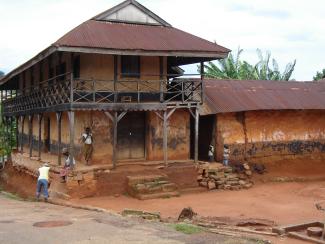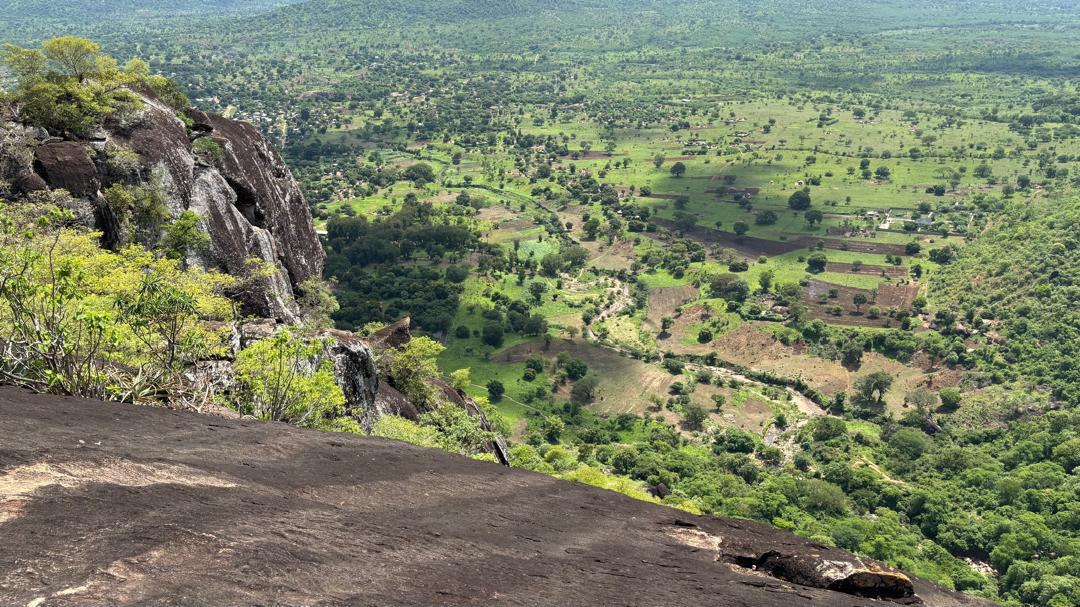Housing
Crumbling structures

Mud houses have a long tradition in West Africa. Among the best-known are the Dogon villages in Mali, built of a mixture of earth and straw. Some of them are more than thousand years old and protected by UNESCO as a World Heritage. The Great Mosque of Djenné in Mali is the largest mud building in the world. Countries as far apart as Cameroon, with the high Musgum houses made of sun-dried mud, and Sierra Leone, with Limba villages constructed with bamboo and mud, are examples of West Africa’s rich architectonic heritage.
In Ghana, traditional houses built of mud provide accommodation for households in villages, small towns and major cities. Mud houses are an important feature of historical urban structures.
In Ghana's south, the traditional architectural design of mud houses is rectangular. These structures normally have roofs of iron or aluminium sheets. Mud walls need protection from rain. In Ghana's drier north, most mud buildings are round and have straw roofs. Some houses date back to before 1850 when the British took over the administration of the territory.
The traditional structures are typically referred to as “compound houses”. In general, they accommodate two or more households, usually of the same lineage. They are often considered “family houses”. In the southern towns, there are even multi-storey buildings that accommodate up to 20 households. More recently built houses, however, usually are too small to serve extended families.
Unfortunately, many traditional mud houses are in bad shape. The general problem is poor maintenance. Many mud houses are dilapidated. A core challenge is that their foundations are exposed to erosion and show signs of weakness. Research in Ghana's southern forest belt shows that the foundations of many buildings are severely exposed, at times to a depth of almost a metre, which leaves the whole structure shaky.
Sweeping around the house with a broom makes matters worse, because it loosens the soil and induces further erosion. Sadly, the collapse of mud houses is a common occurrence. However, there are no systematic statistics about the number of houses affected and households concerned.
Though erosion is a serious problem in many places, most people simply do not know what to do about it. Planting grass can help. Simple drainage systems are useful too. This kind of knowledge needs to be spread.
The introduction of cement and sandcrete blocks has led to less use of mud for construction, but most communities now use various building materials, including mud. "Swish", which is composed of mortar and mud or laterite, is quite common. People also mix cement and earth. The erosion problem will therefore continue to threaten the stability of buildings, and to the extent that climate change leads to more or heavier rainfall, it will be compounded.
Severe housing shortage
Ghana faces acute housing problems. The situation is getting worse due to rapid population growth and increasing urbanisation. According to UN-HABITAT, Ghana needs approximately 120,000 additional housing units every year.
Construction of housing is largely left to private individuals and estate companies, whereas the policy focus used to be on state provision of housing in the past. According to the Bank of Ghana, private real estate developers constructed some 11,000 housing units annually on average from 2000 and 2007. These units, however, are usually too expensive for low and middle-income households.
In 2005, the government of Ghana initiated a programme to build over 100,000 units of affordable housing through private-public partnerships (PPP) across the country. But to a large extent, the government only focussed on cities, where real estate companies find the housing market attractive. In other areas, the housing shortage is getting worse. To ease the crisis, it would make sense to invest in the protection of traditional mud houses.
Policy failure
In 2011, UN-HABITAT published its Ghana Housing Profile report. It recognises the importance of the traditional mud houses for providing shelter, but it neither highlights what is threatening these buildings nor does it offer recommendations on protection and maintenance.
The track record of Ghanaian institutions is not better.
- Ghana's Environmental Protection Agency lists coastal erosion due to the rising sea level as one of the nation's environmental problems, but it does not mention erosion in built environments and its impact on housing structures.
- The Draft National Housing Policy of 2012 (NHP) includes no initiative to address the matter. Kwadwo Yeboah, the principal town planner at the Ministry of Local Government and Rural Development, says he is “surprised that the issues of erosion within the communities and the condition of our mud houses have not been captured in the housing policy”.
- Ghana has Metropolitan, Municipal and District Assemblies (MMDAs), but they are not mandated to tackle housing needs in their jurisdiction. There are MMDA environment and sanitation plans, but they hardly mention erosion.
- The national government's Town and Country Planning Department (TCPD) is responsible for managing the growth of cities, towns and villages. It regulates land-use plans and advises the MMDAs. However, it has not addressed the conditions of housing structures.
As the government does not have a policy on erosion, it is left to the owners of mud houses to keep the phenomenon in check as best they can. Planting grass and providing drainage help, but are not enough. More can and should be done, and policy needs to be geared to that purpose:
- At the national level, the Ministry of Works and Housing should recognise the traditional mud houses as an important component of the country’s housing stock and develop policies to sustain them.
- The Ministry of Environment, Science and Technology should take into account that erosion is threatening buildings and compounding the housing crisis. It should draft a programme accordingly and put the MMDAs in charge of implementation.
- The MMDAs should initiate community-level debate and involve local leaders, addressing erosion in all kinds of settlements. There is a need to sensitise and educate community members on low-cost erosion control measures such as planting of grass around housing units.
- Traditional leaders and opinion leaders should make efforts to revive the dying culture of communal labour to address environmental problems including erosion control within settlements. Accordingly, the MMDAs should intensify efforts at providing financial and material support for the construction of drains to regulate run-off within townships and villages.
Benjamin D. Ofori is research fellow at the University of Ghana's Institute for Environment and Sanitation Studies (IESS).
bdofori@ug.edu.gh
Jesse S. Ayivor is also a research fellow at the IESS.
jsayivor@ug.edu.gh







